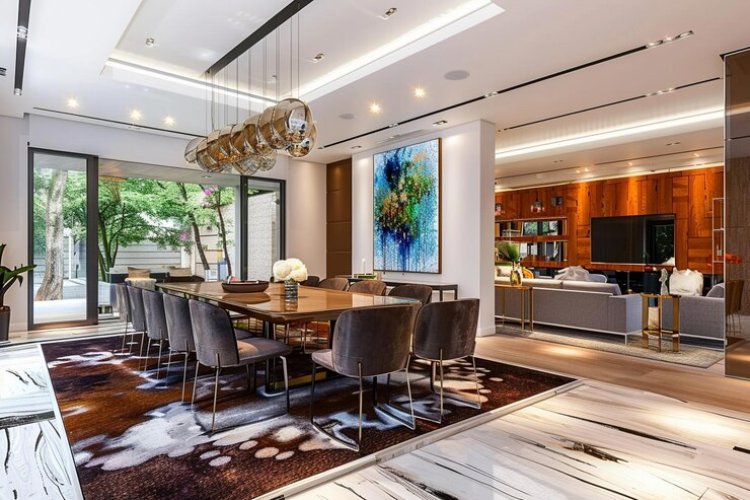How to Make a Small Room Feel Larger with Design Tricks?
Small rooms should still feel like home. Add a few personal touches, such as family photos or souvenirs, but don’t overdo it. Keep the overall design clean and uncluttered for the best effect.
Share this Post to earn Money ( Upto ₹100 per 1000 Views )

If you’re dealing with a small room that feels cramped and closed off, don’t worry. With a few clever design tricks, you can transform your space into a bright, open, and inviting area. Whether you're working with a residential architect Singapore or exploring ideas on your own, these tips will help you unlock the potential of your cosy room.
1. Use Light Colours to Open Up the Space
Colour has a powerful effect on how we perceive space. Light colours like white, cream, soft grey, and pastels can make a room feel bigger. They reflect more light, giving the illusion of openness. When choosing paint, consider an eggshell or satin finish for walls, as these reflect light better than matte finishes.
If you prefer a bit of contrast, keep the base light and add darker shades sparingly through furniture or decor. This creates depth without overwhelming the space.
2. Go for Multifunctional Furniture
Furniture in small rooms should work smarter, not harder. Look for pieces that serve multiple purposes. For example:
-
A sofa bed for guests.
-
Ottomans with hidden storage.
-
Dining tables that fold away when not in use.
Multifunctional furniture reduces clutter and keeps your room looking tidy, which is key to making it feel larger.
3. Maximise Natural Light
Natural light is one of the best ways to make a small room appear larger. Avoid heavy curtains or dark blinds that block light. Instead, opt for sheer curtains or light-filtering shades.
Position mirrors strategically to reflect light around the room. Place a large mirror opposite a window to bounce light and create the illusion of more space. Residential interior design experts often use this trick to make rooms feel more expansive.
4. Keep the Flooring Consistent
Using the same flooring throughout your home can create a seamless flow between rooms. This eliminates visual breaks that make spaces feel smaller. If you’re renovating, consider light-coloured wood, tiles, or laminate flooring for an airy feel.
Rugs can add texture and warmth, but avoid overly busy patterns. Stick to neutral or single-tone rugs that complement your room’s colour palette.
5. Opt for Built-In Storage
Clutter shrinks a room faster than anything else. Built-in storage solutions help keep belongings out of sight while maximising space. Consider these ideas:
-
Shelves that go up to the ceiling.
-
Under-bed storage for seasonal items.
-
Built-in wardrobes with sliding doors.
If you’re working with a residential architect in Singapore, they can help design custom storage solutions tailored to your space.
6. Think Vertical
When floor space is limited, look up. Vertical design draws the eye upward, creating the illusion of height. Some ways to use vertical space include:
-
Hanging tall curtains to make windows look larger.
-
Installing floating shelves or wall-mounted storage.
-
Adding a gallery wall with artwork that extends toward the ceiling.
7. Choose Slimline Furniture
Bulky furniture eats up precious space. Instead, pick slimline pieces that leave more room to move around. For instance:
-
Opt for a sleek loveseat instead of a large sofa.
-
Choose dining chairs with open backs.
-
Use a coffee table with legs to create a sense of openness.
Lightweight furniture keeps the room feeling airy and prevents it from feeling overcrowded.
8. Declutter and Organise
Less is more when it comes to small rooms. Go through your belongings and get rid of items you no longer need. Invest in organisers to keep everything in its place.
Adopt a minimalist approach to decor. A few well-chosen pieces, such as a statement lamp or a bold piece of artwork, can make a strong impact without overwhelming the space.
9. Play with Scale and Proportions
Mixing different sizes of furniture and decor can make a small room more interesting. For example, a small armchair paired with a tall floor lamp can add visual contrast and draw the eye around the space.
However, avoid overloading the room with too many pieces. Aim for balance by leaving some empty space to let the room breathe.
10. Incorporate Glass and Reflective Surfaces
Glass furniture, like coffee tables or desks, can make a room feel larger by reducing visual weight. Reflective surfaces, such as mirrored cabinets or shiny decor, also add a sense of depth.
These materials are perfect for small spaces as they trick the eye into seeing more room than there actually is.
11. Add Greenery Wisely
Plants bring life and vibrancy to any space, but in small rooms, less is more. Choose one or two medium-sized plants rather than several small ones to avoid clutter. Hanging plants or wall-mounted planters are great options that save floor space.
12. Use Zone Lighting
Lighting plays a huge role in shaping how we perceive space. Layer your lighting by combining:
-
Ceiling fixtures for general light
-
Table or floor lamps for focused light
-
LED strips under shelves for ambient light
Avoid harsh lighting. Instead, go for warm, diffused light to make the room feel cosy and inviting.
13. Opt for Sliding Doors
Hinged doors take up valuable floor space when they swing open. Sliding doors are a fantastic alternative for small rooms. They’re sleek, functional, and help maintain an open flow between spaces.
In Singapore, residential architects often recommend sliding doors for homes with limited space. They’re especially useful for wardrobes, bathrooms, and connecting rooms.
14. Create Focal Points
Every room needs a focal point to draw attention. In a small room, this could be a:
-
Feature wall with bold wallpaper or paint
-
Statement piece of furniture, like a unique chair
-
Eye-catching piece of artwork
By focusing attention on one area, the rest of the room feels less cramped.
15. Add Personal Touches Sparingly
Small rooms should still feel like home. Add a few personal touches, such as family photos or souvenirs, but don’t overdo it. Keep the overall design clean and uncluttered for the best effect.
Final Thoughts
Making a small room feel larger with residential design doesn’t require a big budget. With smart planning and thoughtful design, you can turn any compact space into a functional and beautiful area. Whether you’re tackling the project yourself or hiring a residential architect in Singapore, remember that every detail matters. Focus on light, layout, and clutter-free living to create a space you’ll love.
Ready to explore more? Contact a residential interior design expert today and start transforming your small room into a spacious retreat. At TOPOS, we specialise in turning small spaces into stunning, functional areas. Let our expertise in residential interior design help bring your vision to life.

 vanshika
vanshika 














